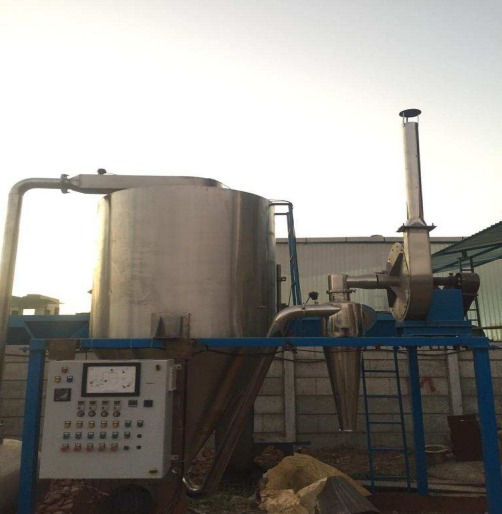Spray dryers are primarily used for drying solutions and slurries into powders. We are offering plants for a variety of applications ranging from heat-sensitive products like enzymes, blood, flavors, regular products like plant and animal extracts, milk, food and pharmaceutical applications, dyes, and chemicals, detergents, catalysts to heat-resistant products like ceramics, inorganic salts, glass, and metals, etc.
Depending upon the end product requirement there are different designs like rotary atomizers, pressure nozzle towers, or two-fluid nozzle type spray dryers.
All plants are tailored designed taking into account the special needs of the application to deliver the optimum performance.

We render our maximum efforts to fulfil customer requirement in achieving best quality with best competitive price.
Step 1: Atomization
The liquid feed is introduced into the atomizer or nozzle, where it is transformed into fine droplets. The size and distribution of the droplets can be adjusted based on the specific requirements of the drying process.
Step 2: Droplet Drying
The atomized droplets are introduced into the drying chamber, where they encounter the heated airstream. As the droplets travel through the drying chamber, the hot air rapidly evaporates the liquid component, leaving behind dry particles. The droplets shrink in size until they become solid particles.
Step 3: Powder Collection
Once the droplets have been completely dried, the resulting dry powder is separated from the drying air. This is typically achieved using a cyclone separator or a bag filter. The dry particles are collected at the bottom of the separator or filter, while the air and any remaining moisture are discharged.
5. Conclusion
Spray drying is a highly efficient method for transforming liquid substances into dry powders. By atomizing the liquid feed into fine droplets and exposing them to hot air, spray dryers can quickly and effectively remove moisture while preserving the properties of the original substance. Understanding the working principle of a spray dryer is essential for optimizing drying processes and achieving high-quality dry powders in various industries.
Spray dryers are broadly classified into two types based on the method of atomization. These are :
There are various arrangements of the spray dryers depending upon the pattern of air flow, type of pollution control equipment used, type of air heating method used. Following are the sub types of spray dryers depending upon the air flow pattern.
We Are Here To Help You 7 Days A Week And Respond Within 24 Hours. Plus, You Can Find the Most Answers To Your Questions.

Spray drying is a technique commonly employed in industries such as food, pharmaceuticals, chemicals, and ceramics. It involves atomizing a liquid feed into droplets and rapidly drying them through contact with a stream of hot air. The result is a dry powder with preserved properties and characteristics of the original substance.
Fully automatic spray dryers have revolutionized the drying industry by streamlining and optimizing the spray drying process. These advanced systems offer enhanced efficiency, improved product quality, and increased productivity. With applications spanning various industries, fully automatic spray dryers play a crucial role in converting liquid substances into high-quality, dry powders.

A semi-automatic spray dryer is a specialized equipment used in the spray drying process. It is designed to facilitate the atomization and drying of liquid or slurry feedstock. Unlike fully automatic spray dryers, which require minimal human intervention, semi-automatic spray dryers offer a balance between automation and manual control. This allows operators to have greater control over the drying process while benefiting from the efficiency and repeatability provided by the automated features.
A semi-automatic spray dryer operates based on the same fundamental principles as a conventional spray dryer. The liquid or slurry feedstock is pumped into the spray dryer, where it comes into contact with a high-velocity hot gas stream. This interaction causes the liquid to evaporate rapidly, leaving behind dry particles or powders. The semi-automatic nature of the spray dryer means that certain operational parameters, such as feed rate, temperature, and pressure, can be adjusted manually to optimize the drying process.
We are working as a renowned Spray Dryer, Flash Dryer, Spin Flash Dryer, Evaporator, Fluid Bed Dryer, Blowers, Feeding Systems, Hot Air Generator manufacturer, exporter, supplier and service provider.
Plot No. 5/1 B, Panchrantra Industrial Estate, Ramol - Vatva Over Brdge, Phase - 1, Vatva G.I.D.C, Vatva, A'bad
info@drytechengg.com
+91 98986 82370
WhatsApp us